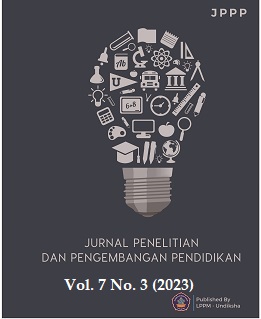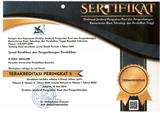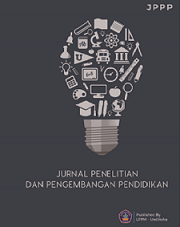Pemanfaatan Augmented Reality untuk Keterampilan Komunikasi Sosial Anak dengan Gangguan Spektrum Autisme
DOI:
https://doi.org/10.23887/jppp.v7i3.67481Keywords:
Augmented Reality, keterampilan komunikasi sosial, gangguan spektrum autismeAbstract
Gangguan spektrum autisme (ASD) adalah gangguan neurologis yang menyebabkan anak yang didiagnosis mungkin menghadapi kesulitan dalam komunikasi sosial atau memiliki serangkaian perilaku yang berulang atau terbatas. Tujuan penelitian ini untuk menganalisis pemanfaatan augmented reality untuk keterampilan komunikasi sosial anak dengan gangguan spektrum autisme. Jenis penelitian ini merupakan penelitian kualitatif. Pengumpulan data dengan menggunakan metode kualitatif maupun kuantitatif. Subjek penelitian terdiri dari berbagai kelompok usia dan tingkat keparahan dan harus mencakup kedua jenis kelamin. Hasil penelitian menunjukkan efek penggunaan AR terhadap pembelajaran individu adalah positif. Namun, mengingat beragam keterampilan yang ditargetkan dalam studi terpilih, dan heterogenitas peserta, kesimpulan sumatif mengenai keefektifan AR untuk mengajarkan keterampilan komunikasi sosial kepada individu dengan ASD berdasarkan literatur yang ada tidak mungkin dilakukan. Kefektifan relatif AR di antara lebih banyak peserta, teknologi berbeda yang mendukung AR, intervensinya, dan evaluasi di lingkungan kelas diperlukan. Penelitian ini memberikan wawasan tentang solusi berbasis augmented reality (AR) yang dikembangkan untuk gangguan spektrum autisme (ASD).
References
Auliya, R. N., & Munasiah, M. (2020). Augmented Reality Affects Students’ Attitude and Conceptual Understanding in Learning 3D Geometry. JPI (Jurnal Pendidikan Indonesia), 9(2), 203–212. https://doi.org/10.23887/jpi-undiksha.v9i2.17480. DOI: https://doi.org/10.23887/jpi-undiksha.v9i2.17480
Dinayusadewi, N. P., & Agustika, G. N. S. (2020). Development of augmented reality application as a mathematics learning media in elementary school geometry materials. Journal of Education Technology, 4(2). https://doi.org/10.23887/jet.v4i2.25372. DOI: https://doi.org/10.23887/jet.v4i2.25372
Dwivedi, Y. K., Ismagilova, E., Hughes, D. L., Carlson, J., Filieri, R., Jacobson, J., Jain, V., Karjaluoto, H., Kefi, H., Krishen, A. S., Kumar, V., Rahman, M. M., Raman, R., Rauschnabel, P. A., Rowley, J., Salo, J., Tran, G. A., & Wang, Y. (2021). Setting the future of digital and social media marketing research: Perspectives and research propositions. International Journal of Information Management. https://doi.org/10.1016/j.ijinfomgt.2020.102168. DOI: https://doi.org/10.1016/j.ijinfomgt.2020.102168
Fajrin, F., & Leonardi, T. (2019). Hubungan Persepsi Iklim Sekolah Dengan Keterlibatan Orang Tua Dalam Pendidikan Anak Dengan Gangguan Spektrum Autisme (Gsa). Jurnal Psikologi Pendidikan Dan Perkembangan, 8(1), 69–79. DOI: https://doi.org/10.33024/jpm.v1i1.1408
Hao, K. C., & Lee, L. C. (2021). The development and evaluation of an educational game integrating augmented reality, ARCS model, and types of games for English experiment learning: an analysis of learning. Interactive Learning Environments, 29(7), 1101–1114. https://doi.org/10.1080/10494820.2019.1619590. DOI: https://doi.org/10.1080/10494820.2019.1619590
Hoof, L. van B., Hermans, D., Knoors, H., & Verhoeven, L. (2016). Benefits of augmentative signs in word learning: Evidence from children who are deaf/hard of hearing and children with specific language impairment. Research in Developmental Disabilities, 59. https://doi.org/10.1016/j.ridd.2016.09.015. DOI: https://doi.org/10.1016/j.ridd.2016.09.015
Ibáñez, M. B., & Delgado-Kloos, C. (2018). Augmented reality for STEM learning: A systematic review. Computers & Education, 123, 109–123. https://doi.org/10.1016/j.compedu.2018.05.002. DOI: https://doi.org/10.1016/j.compedu.2018.05.002
Ivonne, H. P. A., Alberto, M. P. M., & Guadalupe, C. F. R. (2020). Augmented reality application for teaching basic operations with fractions of the same denominator. Journal of Computer Science, 16(7), 1042–1062. https://doi.org/10.3844/jcssp.2020.1042.1062. DOI: https://doi.org/10.3844/jcssp.2020.1042.1062
Klein, A., Sørensen, C., de Freitas, A. S., Pedron, C. D., & Elaluf-Calderwood, S. (2020). Understanding controversies in digital platform innovation processes: The Google Glass case. Technological Forecasting and Social Change, 152, 119883. https://doi.org/10.1016/j.techfore.2019.119883. DOI: https://doi.org/10.1016/j.techfore.2019.119883
Lee, I. J., Chen, C. H., Wang, C. P., & Chung, C. H. (2018). Augmented reality plus concept map technique to teach children with ASD to use social cues when meeting and greeting. The Asia-Pacific Education Researcher, 27, 227–243. https://doi.org/10.1007/s40299-018-0382-5. DOI: https://doi.org/10.1007/s40299-018-0382-5
Li, X., Yi, W., Chi, H. L., Wang, X., & Chan, A. P. (2018). A critical review of virtual and augmented reality (VR/AR) applications in construction safety. Automation in Construction, 86, 150–162. https://doi.org/10.1016/j.autcon.2017.11.003. DOI: https://doi.org/10.1016/j.autcon.2017.11.003
Lima, C. B. De, Walton, S., & Owen, T. (2022). A critical outlook at augmented reality and its adoption in education. Computers and Education Open, 3, 100103. https://doi.org/10.1016/j.caeo.2022.100103. DOI: https://doi.org/10.1016/j.caeo.2022.100103
Lubis, A. H., & Dasopang, M. D. (2020). Pengembangan Buku Cerita Bergambar Berbasis Augmented Reality untuk Mengakomodasi Generasi Z. Jurnal Pendidikan: Teori, Penelitian, Dan Pengembangan, 5(6), 780. https://doi.org/10.17977/jptpp.v5i6.13613. DOI: https://doi.org/10.17977/jptpp.v5i6.13613
Maijarern, T., Chaiwut, N., & Nobnop, R. (2018). Augmented reality for science instructional media in primary school. 3rd International Conference on Digital Arts, Media and Technology, ICDAMT. https://doi.org/10.1109/ICDAMT.2018.8376523. DOI: https://doi.org/10.1109/ICDAMT.2018.8376523
Razmkon, A., Maghsoodzadeh, S., & Abdollahifard, S. (2022). The effect of deep brain stimulation in children and adults with autism spectrum disorder: A systematic review. Interdisciplinary Neurosurgery, 29, 101567. https://doi.org/10.1016/j.inat.2022.101567. DOI: https://doi.org/10.1016/j.inat.2022.101567
Simon, M., Wilkes-Gillan, S., Chen, Y. W. R., Cordier, R., Cantrill, A., Parsons, L., & Phua, J. J. (2022). Toilet training interventions for children with autism spectrum disorder: A systematic review. Research in Autism Spectrum Disorders, 99, 102049. https://doi.org/10.1016/j.rasd.2022.102049. DOI: https://doi.org/10.1016/j.rasd.2022.102049
Sirakaya, M., & Cakmak, E. K. (2018). The effect of augmented reality use on achievement, misconception and course engagement. Contemporary Educational Technology, 9(3), 297–314. https://doi.org/10.30935/cet.444119. DOI: https://doi.org/10.30935/cet.444119
Syawaludin, A., Gunarhadi, & Rintayati, P. (2019). Development of augmented reality-based interactive multimedia to improve critical thinking skills in science learning. International Journal of Instruction, 12(4), 331–344. https://doi.org/10.29333/iji.2019.12421a. DOI: https://doi.org/10.29333/iji.2019.12421a
Utami, F., Rukiyah, R., & Andika, W. D. (2021). Pengembangan Media Flashcard Berbasis Augmented Reality pada Materi Mengenal Binatang Laut. Jurnal Obsesi : Jurnal Pendidikan Anak Usia Dini, 5(2), 1718–1728. https://doi.org/10.31004/obsesi.v5i2.933. DOI: https://doi.org/10.31004/obsesi.v5i2.933
Yavuz, M., Çorbacıoğlu, E., Başoğlu, A. N., Daim, T. U., & Shaygan, A. (2021). Augmented reality technology adoption: Case of a mobile application in Turkey. Technology in Society, 66. https://doi.org/10.1016/j.techsoc.2021.101598. DOI: https://doi.org/10.1016/j.techsoc.2021.101598
Downloads
Published
How to Cite
Issue
Section
License
Copyright (c) 2023 Wagino, Sujarwanto , Fairus Niratama

This work is licensed under a Creative Commons Attribution-ShareAlike 4.0 International License.
Authors who publish with the Jurnal Penelitian dan Pengembangan Pendidikan agree to the following terms:
- Authors retain copyright and grant the journal the right of first publication with the work simultaneously licensed under a Creative Commons Attribution License (CC BY-SA 4.0) that allows others to share the work with an acknowledgment of the work's authorship and initial publication in this journal.
- Authors are able to enter into separate, additional contractual arrangements for the non-exclusive distribution of the journal's published version of the work (e.g., post it to an institutional repository or publish it in a book), with an acknowledgment of its initial publication in this journal.
- Authors are permitted and encouraged to post their work online (e.g., in institutional repositories or on their website) prior to and during the submission process, as it can lead to productive exchanges, as well as earlier and greater citation of published work. (See The Effect of Open Access)








